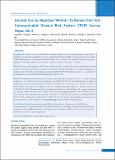Please use this identifier to cite or link to this item:
https://hdl.handle.net/20.500.14356/1775| Title: | Alcohol Use by Nepalese Women: Evidence from Non Communicable Disease Risk Factors STEPS Survey Nepal 2013 |
| Authors: | Aryal, K K Thapa, P Mehata, S Vaidya, A Pandey, A R Bista, B Pandit, A Pandit, P Dhimal, M Karki, K B |
| Citation: | Aryal KK, Thapa P, Mehata S, Vaidya A, Pandey AR, Bista B, Pandit A, Dhakal P, Dhimal M, Karki KB. Alcohol Use by Nepalese Women: Evidence from Non Communicable Disease Risk Factors STEPS Survey Nepal 2013. J Nepal Health Res Counc. 2015 Jan-Apr;13(29):1-6. PMID: 26411705. |
| Issue Date: | 2015 |
| Publisher: | Nepal Health Research Council |
| Article Type: | Original Article |
| Keywords: | Alcohol use NCD risk factor Nepal Women |
| Series/Report no.: | Jan-April, 2015; |
| Abstract: | Abstract Background: Over the centuries, the world has witnessed alcohol use as a common phenomenon among the male population. Owing to the vulnerability of women towards alcohol and its possible consequences on women as well as children when pregnant or lactating mothers drink alcohol, there is utmost need to know the alcohol use among this population. The study sought to assess alcohol use among the Nepalese women aged 15-69 years. Methods: It was a sub-set analysis of 2807 women aged 15-69 years, extracted from a data of national cross-sectional study, NCD Risk Factors: STEPS Survey Nepal 2013 carried out among 4200 adults in 2013 using a multistage cluster sampling. Data collected in personal digital assistants using WHO NCD STEPS instrument version 2.2 were transferred to Microsoft Excel, cleaned in SPSS 16.0, and analyzed in STATA 13.0. Results: We reported 11.7% (95% CI: 9.5-14.3) ever users of alcohol, 9.4% (95% CI: 7.4-11.7) last 12 months alcohol users, 7.1% (95% CI: 5.2-9.0) current drinkers, and 0.9% (95% CI: 0.5-1.6) with harmful use of alcohol. As compared to 15-29 years women, 30-44 and 45-69 years women were 1.61 (95% CI: 1.02-2.55) and 1.58 (95% CI: 1.03-2.43) times more likely to be drinkers in the last 12 months, respectively. Likewise, 45-69 years women were 2.84 (95% CI: 1.05-7.63) times more likely to indulge into harmful use of alcohol than their younger counterparts (15-29 years). Women from the Terai belt had lower odds of any drinking pattern than the women from hills: ever use (0.43, 95% CI: 0.27-0.70), alcohol use in the last 12 months (0.44, 95% CI: 0.26-0.75), current drinking (0.38, 95% CI: 0.22-0.65), and harmful use of alcohol (0.11, 95% CI: 0.03-0.37). Primary education holders were found to have 0.64 times (95% CI: 0.43-0.95) chances of current drinking than those without formal education. Conclusions: Women from upper age groups, hills, and with no formal education were found likely to be consuming alcohol. Contextual and culture friendly anti alcohol behaviour change communication interventions on community settings of hills and mountains, promoting active participation of relatively older women (45-69 years) and illiterate women are of great importance. Keywords: Alcohol use; NCD risk factor; Nepal; women. |
| Description: | Original Article |
| URI: | http://103.69.126.140:8080/handle/20.500.14356/1775 |
| ISSN: | Print ISSN: 1727-5482; Online ISSN: 1999-6217 |
| Appears in Collections: | Vol. 13 No. 1 Issue 29 January - April 2015 |
Items in DSpace are protected by copyright, with all rights reserved, unless otherwise indicated.

